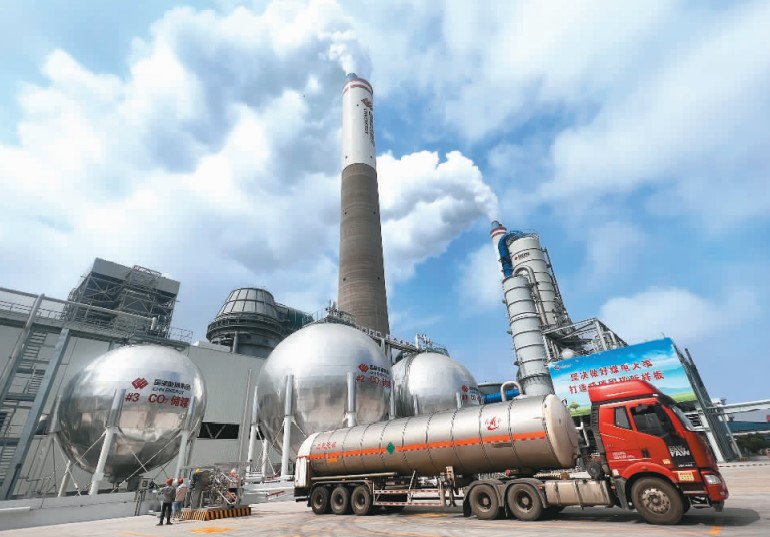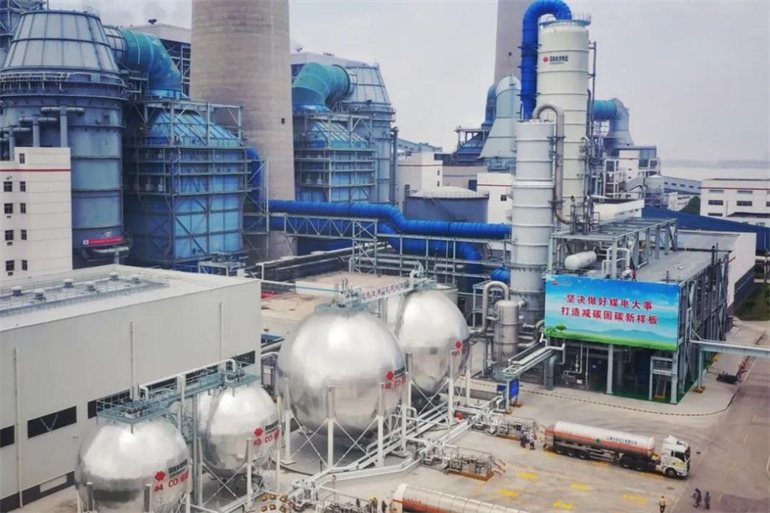Asia's largest carbon capture project put into use in E China's Jiangsu
The assumption that carbon dioxide (CO2) in the atmosphere can be captured and reutilized has become a reality, as Asia's largest carbon capture, utilization and storage (CCUS) facility for the coal-fired power generation sector was put into operation in east China's Jiangsu province on June 2.
The facility, attached to a generation unit at China Energy's Taizhou coal-fired power plant, is expected to capture 500,000 tons of CO2 every year, which will be wildly used in the industrial and food sectors.

A transport truck waits to load CO2 at the Taizhou coal-fired power plant of China Energy. [Photo/Liao Ruiling]
At the facility, compressed liquid CO2 is transferred between three operation towers and four gigantic silvery spherical gas storage tanks via long pipelines in white and blue, and then shipped to downstream enterprises by transport trucks.
"This is the capture area, which covers about 1,650 square meters, the smallest unit area compared with other CCUS facilities already in place," said an employee working at the facility.
CCUS is a technology that captures and purifies CO2 emitted during production and then puts it into reutilization or storage. It helps realize the low-carbon utilization of fossil energy.
Carbon capture aims at reducing carbon emissions. Energy conservation and carbon reduction have become a consensus of all sectors of society since China vowed to have CO2 emissions peak before 2030 and achieve carbon neutrality before 2060, also known as the "dual carbon" goal.
Coal-fired power generation, which ensures the basic supply of energy, is a large emitter of CO2. CCUS is considered one of the key technical methods that are able to realize the clean and efficient utilization of coal and minimize the environmental impacts caused by coal-fired power generation.
The CO2 capture rate of the CCUS facility in the plant stands at over 90 percent, which can produce CO2 at 99 percent purity with the dry base technique, said Gong Haiting, director of the carbon resource development office of the Taizhou coal-fired power plant of China Energy, adding that the facility is both environment-friendly and exemplary in the commercialization of carbon capture.
The three towers, namely the scrubber tower, the absorption tower and the regeneration tower, play a vital role in capturing the invisible and impalpable CO2, said an employee of the Taizhou coal-fired power plant.

Photo shows the Taizhou coal-fired power plant of China Energy. [Photo/Li Hui]
The gas emitted by the plant meets national environmental standards, which contains 10 to 15 percent of CO2, the employee explained, adding that the CCUS facility captures the flue gas emitted from generation unit No. 4 of the plant.
It is learned that the flue gas would first enter the scrubber tower via induced draft fans, where it is cooled down and decontaminated. Then in the absorption tower, over 90 percent of the CO2 in the flue gas would be absorbed and transferred to the regeneration tower for liquefaction and compression. Finally, the compressed liquid CO2 would be stored in the storage tanks.
Before the facility came into service in the Taizhou coal-fired power plant, some other CCUS facilities had already been put into use. However, their profit is hardly stable due to immature technologies and business models. Today, the China Energy facility serves as a successful example in this regard.
According to Gong, the development team of the facility had already located clients in welding, food-grade dry ice and high-tech machinery cleaning industries based on massive market research in the Yangtze River Delta region when the project was still at a very early stage.
"There are oilfields and some shipbuilders with great demand of CO2 around our power plant. This means that the facility has a stable source of clients," Gong told People's Daily, adding that the development space is huge in the food-grade dry ice and cold-chain logistics sectors and the clients are satisfied with the CO2 quality offered by the facility.
Thanks to the plentiful market research, all of the CO2 captured by the facility each year would be absorbed by the market, which generates stable profit and serves as an example for the long-term sustainable operation of CCUS projects, Gong said.
Insiders believe that guided by the "dual carbon" goal, China's CCUS industry enjoys broad development space. According to a CCUS report in 2021, the demand for emission reduction in the industry may range from 20 million to 408 million tons by 2030, and China's CCUS market is expected to reach over 330 billion yuan ($46.22 billion) by 2050.
























